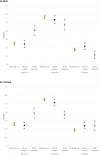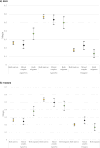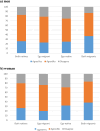Agree to Disagree? Fertility Intentions Among Mixed Couples in Sweden
- PMID: 40768103
- PMCID: PMC12328862
- DOI: 10.1007/s10680-025-09742-w
Agree to Disagree? Fertility Intentions Among Mixed Couples in Sweden
Abstract
Whether couples agree on having a(nother) child is crucial for both individuals and society. While fertility research has long focused on women, recent studies emphasize the need to incorporate both partners' perspectives. However, analyses that jointly consider men's and women's fertility intentions remain scarce. This focus on women has been partly driven by homogamy-the tendency for individuals to select partners with similar traits and values. Given that couples with mixed backgrounds have higher dissolution rates, they may also be less likely to share family-related beliefs. This study examines how agreement on fertility intentions varies among mixed and homogamous couples in Sweden. Using the 2021 Swedish Generation and Gender Survey (GGS) and stratifying by respondents' gender, we find that most couples agree not to have a(nother) child, reflecting recent fertility declines. Couples where both partners are migrants exhibit the highest agreement, while mixed couples show the most disagreement and the strongest gender asymmetries in reported intentions. However, these differences are small and vary by the gender of the reporting partner. The higher disagreement among mixed couples aligns with broader research on their elevated dissolution risks. However, reverse causality is possible-value differences may be linked to other stressors, making childbearing less desirable. By highlighting the role of couple composition in fertility decision-making, our findings contribute to understanding how family formation dynamics vary across different couple types.
Keywords: Couple perspective; Fertility intentions; GGS; Migrants; Mixed unions; Sweden.
© 2025. The Author(s).
Conflict of interest statement
Declarations. Conflict of interest: No competing interest.
Figures





Similar articles
-
The Black Book of Psychotropic Dosing and Monitoring.Psychopharmacol Bull. 2024 Jul 8;54(3):8-59. Psychopharmacol Bull. 2024. PMID: 38993656 Free PMC article. Review.
-
Different-sex American couples' stress, uncertainty, and fertility desires during the COVID-19 pandemic.Genus. 2025;81(1):19. doi: 10.1186/s41118-025-00257-0. Epub 2025 Jul 1. Genus. 2025. PMID: 40612646 Free PMC article.
-
Sexual Harassment and Prevention Training.2024 Mar 29. In: StatPearls [Internet]. Treasure Island (FL): StatPearls Publishing; 2025 Jan–. 2024 Mar 29. In: StatPearls [Internet]. Treasure Island (FL): StatPearls Publishing; 2025 Jan–. PMID: 36508513 Free Books & Documents.
-
The contribution of medically assisted reproduction to total, age-, and parity-specific fertility in Italy.Hum Reprod. 2025 Jul 10:deaf137. doi: 10.1093/humrep/deaf137. Online ahead of print. Hum Reprod. 2025. PMID: 40639806
-
Antioxidants for male subfertility.Cochrane Database Syst Rev. 2022 May 4;5(5):CD007411. doi: 10.1002/14651858.CD007411.pub5. Cochrane Database Syst Rev. 2022. PMID: 35506389 Free PMC article.
References
-
- Alderotti, G., Mussino, E., & Comolli, C. L. (2023). Natives’ and migrants’ employment uncertainty and childbearing during the great recession: A comparison between Italy and Sweden. European Societies,25(4), 539–573. 10.1080/14616696.2022.2153302
-
- Alderotti, G., Tomassini, C., & Vignoli, D. (2022). ‘Silver splits’ in Europe: The role of grandchildren and other correlates. Demographic Research,46(April), 619–652. 10.4054/DEMRES.2022.46.21
-
- Andersson, G. (2004). Childbearing after migration: Fertility patterns of foreign-born women in Sweden. International Migration Review,38(2), 747–775. 10.1111/j.1747-7379.2004.tb00216.x
-
- Andersson, G., Hank, K., Rønsen, M., & Vikat, A. (2006). Gendering family composition: Sex preferences for children and childbearing behavior in the Nordic countries. Demography,43(2), 255–267. 10.1353/dem.2006.0010 - PubMed
-
- Andersson, G., Persson, L., & Obucina, O. (2017). Depressed fertility among descendants of immigrants in Sweden. Demographic Research,36(1), 1149–1184. 10.4054/DemRes.2017.36.39
Grants and funding
LinkOut - more resources
Full Text Sources
